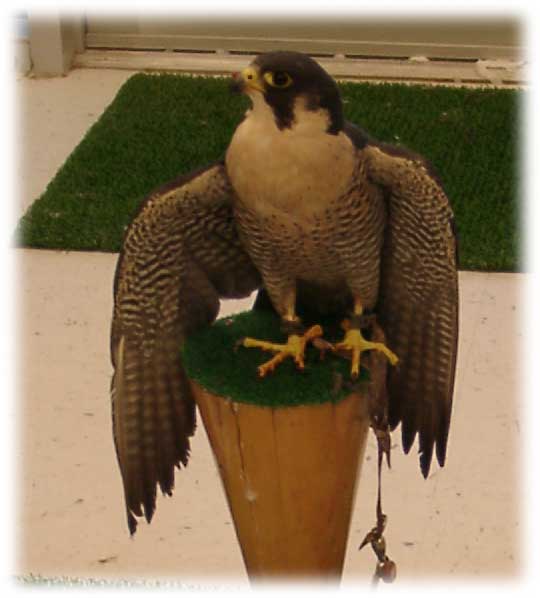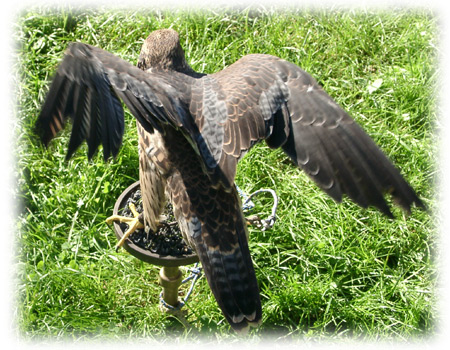This bird is native to North America and Europe and has traditionally been one of the most prized and common birds for falconry. It is highly effective and easily motivated to work with its handler. It is known for its trademark stoop and excels at waiting on. The Peregrine usually nests in high cliffs overlooking water. The move to nesting on skyscrapers is not a huge leap considering their preferred nesting sites.
There are three sub-species in N. America - Tundra Peregrines, Peale's Peregrines, and Anatum Peregrines. Peale's Peregrines inhabit a niche that is difficult. They battle Bald Eagles for food. Perhaps this is where their demeanor comes from as they are generally regarded as less likable, or even more nasty. They tend to be easier to trigger into aggressiveness or screaming. They are more expressive in their body posture and are frequently compared to the Bald Eagle or a Prairie Falcon in terms of their temperament. Contrastingly, the Anatum is prized for a more docile attitude, sweet natured, and easier to motivate. The Anatum inhabits a niche where it catches more game on the wing and competes with other species less. It generally takes more to trigger this bird into aggressiveness or screaming.
Plumage
The adult is dark blue-gray back, wings, and tail. The head is dark with a stripe (like sideburns) running down the side of the face often referred to as a mustache. The breast is light, sometimes a pale reddish-pink color, with barring below.
Immatures are a rich reddish-brown with a cream colored breast and lower body. The juvenile typically has a narrower mustache than the adult.
 |
An immature Peregrine falcon - this one happens to be the first
passage taken in Washington state since the take of wild Peregrines was reopened. |
 |
A mature tundra Peregrine. This bird is owned and flown by the US Air Force Academy. |
 |
First moult for this Peregrine - notice the immature brown feathers and the mature blue-ish feathers which have replaced some of the immature feathers. |
Morphology
The immature Peregrine is particularly easy to identify by its slightly blue feet and cere. This fades to a yellow as they mature. The Peale's is a large, dark bird while the Tundra is smaller. The Anatum is the "classic" North American Peregrine.
Peregrine wing-shape is unique in that the second primary is the longest of all the primaries.
Hunting
Typical quarry caught with the Peregrine are large birds including grouse, pheasant, ducks, huns, pigeons, doves, and ptarmigan. In the wild this bird most typically hunts these same birds with only the occasional small mammal or fish.
This bird is known for it's stooping strikes at quarry. It will ring, or circle, up high above potential prey, thousands of feet up, then fold its wings and drop out of the sky. The attack style is to overtake and attack directly. The strike is aimed at the head of the prey and will kill the target instantly. These birds have been clocked at speeds upwards of 230 mph, and it is thought that they can dive faster than that.
Trivia
The Latin name Falco peregrinus means "wandering falcon". The Peregrine is also referred to as the Duck Hawk, the subspecies anatum means "duck eater". These powerful birds are common hybrids with Gyrfalcons, Merlins, and other falcons.
The term "falcon" traditionally was used to refer to the female Peregrine, however it is now used to commonly refer to any female falcon, and most generally, any member of the falcon genus. The male Peregrine is technically called a Tiercel.
The Peregrine prefers to nest on cliffs overlooking bodies of water. The Anatum prefers nesting on cliffs and is considered quite intelligent and compatible with falconers being readily trained for hunting with her falconer.
The Peregrine suffered a severe population decline and has been recovering for several years now thanks to the efforts of private groups such as The Peregrine Fund, government partnerships, and falconers. American falconers were the first to develop an artificial insemination technique, and individuals such as Heinz Meng and Les Boyd have been of great importance to this effort. In 1964 there were no Peregrines east of the Mississippi River, and the known nest sites in California the mid-1970s only numbered 10. As of 1994 there were over 130 sites.
Links
https://www.mbr-pwrc.usgs.gov/id/framlst/i3560id.html
http://www.peregrine-foundation.ca/